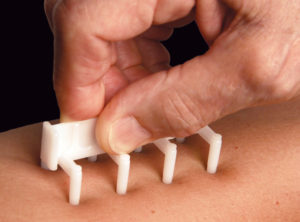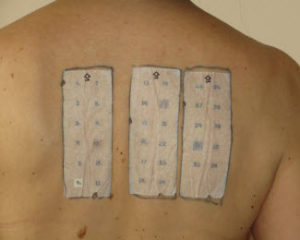You will first meet with a clinical staff member who will check your vital signs and review any other necessary medical information.
The provider will than take a detailed history regarding your symptoms – including lifestyle, recent activities and severity, or relation to possible allergen
exposure, and response to any past treatment. A physical exam will also be done.
After the history and physical exam, and the review of any previous tests or medical records, your allergist will decide if further testing is necessary.
These may include skin testing and lung function tests.
Allergy Skin Testing
 Percutaneous (prick) testing is typically the first step in determining the right treatment plan for you. Testing can be performed to common allergens such as pollens, molds, dust mites, animal dander, insects, various foods and some medications such as Penicillin.
Percutaneous (prick) testing is typically the first step in determining the right treatment plan for you. Testing can be performed to common allergens such as pollens, molds, dust mites, animal dander, insects, various foods and some medications such as Penicillin.
These tests are relatively painless and performed on the back or the patient’s arm. Allergens are applied that penetrate only the top layer of the skin. You may feel a slight prick when the test is applied. After 15 minutes, the skin is checked for a local reaction. If you are allergic to an antigen, you will develop a raised, red bump (wheal) similar to a mosquito bite. The severity of the reaction is determined by the size of the wheal.
 Intradermal testing is generally performed if the skin prick test is inconclusive, and the patient has a strong history of potential allergies. A small amount of the allergen is injected under the first layer of the skin and the results are read and measured after 15 minutes as well.
Intradermal testing is generally performed if the skin prick test is inconclusive, and the patient has a strong history of potential allergies. A small amount of the allergen is injected under the first layer of the skin and the results are read and measured after 15 minutes as well.
 Allergy patch testing may be performed to see whether a particular substance is causing an allergic skin irritation (contact dermatitis). These can include substances such as lotions, cosmetics, metals and hair dyes. Patches with specific allergens are place on the patient’s back for 48 hours. At 48 hours the patches are removed and the skin is examined for any signs of rash or irritation. During this time you should avoid getting the back wet and any activities that may cause sweating. A final review of the skin may also take place after 72 hours to look for a more delayed reaction.
Allergy patch testing may be performed to see whether a particular substance is causing an allergic skin irritation (contact dermatitis). These can include substances such as lotions, cosmetics, metals and hair dyes. Patches with specific allergens are place on the patient’s back for 48 hours. At 48 hours the patches are removed and the skin is examined for any signs of rash or irritation. During this time you should avoid getting the back wet and any activities that may cause sweating. A final review of the skin may also take place after 72 hours to look for a more delayed reaction.
Breathing (Lung Function) Tests
 Spirometry is the most common lung function test. Spirometry can measure many different things about the way you breathe. These include how much air you can exhale, how much air you can breathe in and out in 1 minute, and the amount of air left in your lungs after a normal exhale. It can also measure airway obstruction and response to treatment with a bronchodilator. Children as young as 5 can perform a reliable spirometry with the coaching from our staff, as well as fun incentive graphics on the spirometry machine such as “blowing out birthday candles” to help them perform the test.
Spirometry is the most common lung function test. Spirometry can measure many different things about the way you breathe. These include how much air you can exhale, how much air you can breathe in and out in 1 minute, and the amount of air left in your lungs after a normal exhale. It can also measure airway obstruction and response to treatment with a bronchodilator. Children as young as 5 can perform a reliable spirometry with the coaching from our staff, as well as fun incentive graphics on the spirometry machine such as “blowing out birthday candles” to help them perform the test.
Lung function tests are very important in making an initial diagnosis of asthma, determining its severity, and allowing us to determine which medication and dose needed to get the asthma under the best control possible.
After this initial evaluation and review of all test results, an individual care plan will be made for your diagnosis. This may include more testing, pharmacotherapy, allergy immunotherapy, oral food or medication challenge, and consulting our dietitian or other specialist. Before the end of your appointment your provider and nurse will go over your individual care plan and answer any questions you may have regarding your appointment.
